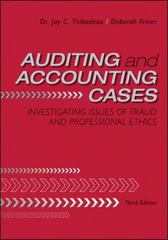Enron paid Arthur Andersen ($46.8) million in fees for auditing, business consulting, and tax work for the
Question:
Enron paid Arthur Andersen \($46.8\) million in fees for auditing, business consulting, and tax work for the fiscal year ended August 31, 1999; \($58\) million in 2000; and more than \($50\) million in 2001.4 Andersen was collecting a million dollars a week from Enron in the year before its crash. Enron was one of Andersen’s largest clients.
More than half of that amount was for fees that were charged for nonaudit services.5 In 2000, for example, Enron paid Andersen \($25\) million for audit .services and \($27\) million for consulting and other services, such as internal audit services.6 In fact, Andersen had performed Enron’s internal audit function since 1993. That year Andersen had hired 40 Enron personnel, including the vice president of internal audit, to be part of Andersen’s team providing internal audit services.7 In 2000, as SEC Chair Arthur Levitt was trying to reform the industry practice of an audit firm also offering consulting services to their audit clients, Enron Chair and CEO Ken Lay sent a letter to Levitt (the letter was secretly coauthored by Andersen partner David Duncan), in which he wrote, While the agreement Enron has with its independent auditors displaces a significant portion of the activities previously performed by internal resources, it is structured to ensure that Enron management maintains appropriate audit plan design, results assessment and overall monitoring and oversight responsibilities. . . . Enron has found its “integrated audit” arrangement to be more efficient and cost-effective than the more traditional roles of separate internal and external auditing functions.8 Interestingly, at Andersen, an audit partner’s compensation depended in large part on his or her ability to sell other services (in addition to auditing) to clients.9 Therefore, the nonaudit services provided to Enron had a big impact on the salary of the lead Andersen partner on the Enron engagement, David Duncan, who was earning around \($1\) million a year.10 Close Ties between Enron and Andersen After graduating from Texas A&M University, Duncan joined Andersen in 1981, was made partner in 1995, and was named the lead partner for Enron two years later. Duncan developed a close personal relationship with Enron’s Chief Accounting Officer Richard Causey, who himself had worked at Arthur Andersen for almost nine years. Duncan and Causey often went to lunch together, and their families had even taken vacations together.
Case Questions
1. What is auditor independence, and what is its significance to the audit profession? What is the difference between independence in appearance and independence in fact?
2. Identify the services provided by Arthur Andersen that are no longer allowed to be performed. Do you believe that Section 201 was needed? Why or why not?
3. How would these sections of the law have impacted the Enron audit? Do you believe that these sections were needed? Why or why not?
4. Do you believe that Section 301 is important to maintaining independence between the auditor and the client? Why or why not?
Step by Step Answer:

Auditing And Accounting Cases Investigating Issues Of Fraud And Professional Ethics
ISBN: 9780078110818
3rd Edition
Authors: Jay Thibodeau, Deborah Freier





